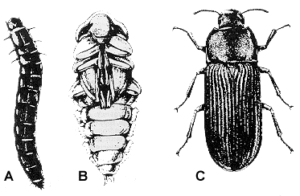Mealworms are not really worms at all but are the larval form of the darkling beetle (Tenebrio molitor). They are clean, easy to raise, do not carry human diseases and most importantly are a nutritious food supplement readily accepted by bluebirds.
Mealworms can be offered to bluebirds to:
- Entice them to use a nest box
- Assist the incubating female to find food quickly so she does not have to leave her eggs for long periods of time
- Act as supplementary food for nestlings if food becomes scarce when weather conditions prevent the parents from finding insects
- Help them survive during spells of severe winter weather
Care of Mealworms
Mealworms are easy to raise, requiring only a grain source such as wheat bran, cornmeal, chicken mash or oatmeal. Add a piece of potato, apple or banana peel on a piece of paper towel or cardboard about once a week to provide moisture. Avoid letting the meal itself become too moist. Mealworms can be kept in a shallow plastic container with a capacity of 2 to 5 gallons, that is covered with a lid that provides good air circulation (a cover of screen or perforated metal can be used). Keep the container in the dark, because as the name darkling beetle implies, they prefer darkness. If you plan on raising mealworms, a piece of cloth can be placed over a portion of the grain to provide a surface on which the adult beetles can lay their eggs. The mealworms will burrow below the surface of the grain and undergo a series of molts. Their development is most rapid at the optimum temperature of 80° F. After the last molt, the larvae come to the surface and metamorphose into naked white pupae for 6 – 18 days and then into beetles. Adult beetles have wings but rarely fly. They lay their eggs 9 – 20 days after emergence and then die. Egg incubation is 4-19 days. Eventually, waste products or “frass” will build up and a slight odor of ammonia will be detected. At this time, the grain needs to be sifted to separate the worms and adult beetles from the old grain; the container washed and new grain added. Dry cat food can be added to the grain to enhance the protein value of the mealworms for the bluebirds. Mealworm metabolism can be slowed down by keeping them in the refrigerator for a few weeks, up to several months (remove the vegetable matter first).
Feeding Mealworms to Bluebirds
Perhaps the biggest challenge is to try to attract bluebirds to your yard with mealworms. If you already have bluebirds and just want to ensure they stay, mealworms can be an effective enticement. If you have never or rarely seen a bluebird in your yard, chances are they will not show up just because you have put out mealworms. What will happen is that other birds in your yard will find them and quickly consume the entire offering. So unless you have bluebirds around, it could be a costly and unrewarding venture to offer mealworms in the hopes of attracting them. However, in cold climates, small over-wintering songbirds like chickadees, nuthatches, etc. appreciate a small hanging tin cup of mealworms as much as bird watchers enjoy watching them come.
There are several types of feeders that can be used, or you can just scatter mealworms on the ground. The latter method is least advised as mealworms are attractive to most birds and they might all be eaten before bluebirds can find them. The best type of feeder is the hopper style where the mealworms can be placed inside the feeder with the bluebirds entering from a hole at either end. Naturally curious, bluebirds will readily explore this type of feeder and quickly recognize it as a food source. The 1 ½” hole at each end will effectively exclude larger birds. Smaller birds will soon catch on, but an aggressive male bluebird will usually defend “his” feeder, especially if he and his mate are nesting nearby. Some find that putting a flat saucer with a few worms in it on top of the hopper feeder will help draw the bluebird’s attention to the location of the feeder. Once they become familiar with the routine, the saucer should be removed and mealworms placed inside the feeder. The location of the feeder can also be moved as the birds become familiar with it, and then moved to a spot where it is easier for you to watch them feed. One of the highlights of feeding mealworms to bluebirds is watching the fledged young start coming down to the feeder, first begging to be fed and eventually figuring out for themselves how to get the tasty treats on their own.
Because they should be used as a supplemental food, mealworms should only be offered once or twice a day unless poor weather conditions dictate more frequent feeding. A hundred or so worms offered morning and evening would be adequate for a pair with a box of nestlings.
Mealworm stages

Several stages in the life history of a mealworm: A. full grown larva, B. pupa, and C. adult beetle (Dupree 1988).
Copyright © 1999 North American Bluebird Society All Rights Reserved
